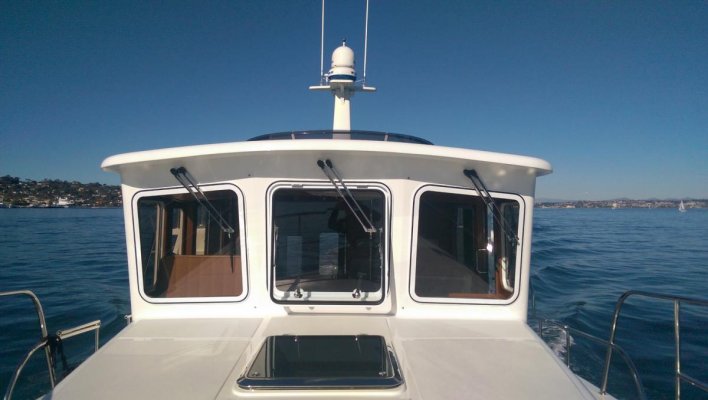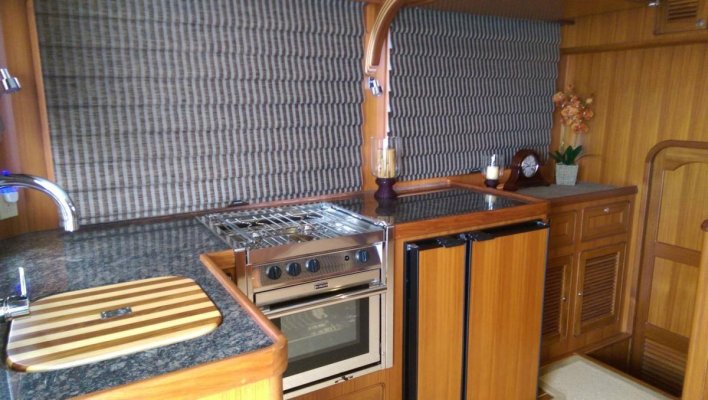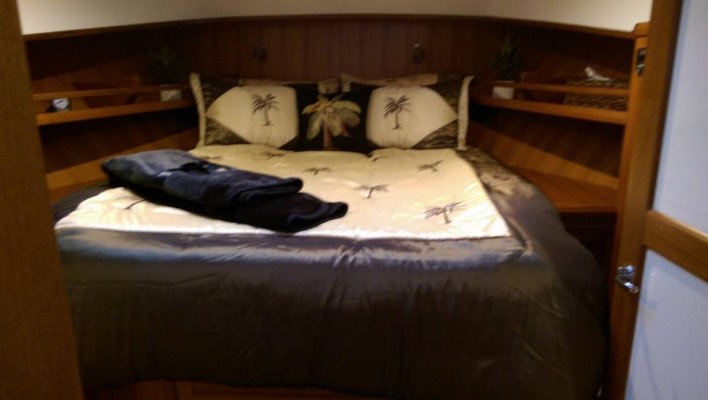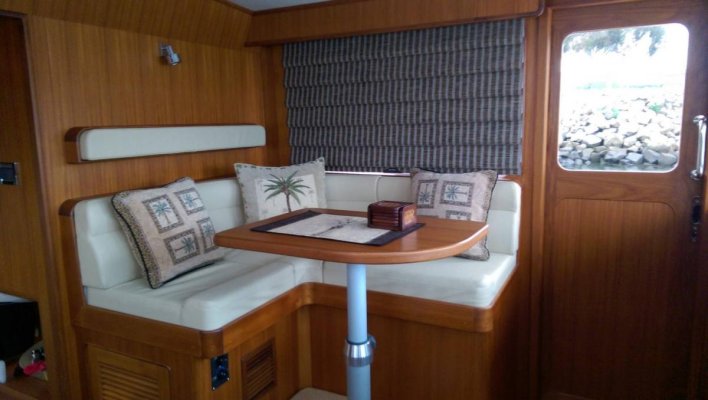Progress Repot
Our first coastal cruise
It’s been three months since we took delivery and completed the commissioning process so we both were excited this past weekend when we finally had a weather window to do a little coastal cruising. It wasn’t anything big but it was our first time “outside” in perfect weather conditions (calm seas and 70 degrees on the water). We pulled out of the marina at 0925hrs (one of the pleasures owning a boat a little faster than FD hull speeds – you don’t have to leave at 0600hrs) and headed out the inlet until we were a few miles off the coast and clear of the kelp beds before turning north towards Mission Bay. After dodging a few lobster pots we set the AP and relaxed as we began to remember what it felt like to be on the water on a perfect day. We could see the whale watching boats who passed us up earlier in the inlet and now cruising along slowly further out off our port side. The ocean was dead calm with our boat causing the only waves as we cruised along at 7.5knots – yes this is heaven.
After about 2.5 hours we were anchored in Mariners Cover near the entrance to Mission Bay, San Diego. We made a few sandwiches and headed back up to the PH where we watched one of the playoff games while we ate. Afterwards we went up top and set up two chairs to enjoy the sun. We must have stayed there an hour before it was time to pull anchor and head back home. Anchor retrieval went fine with Mary at the helm as I worked the windless.
Once we were about 2 miles off the coast we turned to a south / eastern course and set the AP. I conducted my hourly engine room checks (love that ER door) and recorded all information as part of our record keeping and understanding the “normal ranges”. Soon after turning we both noticed a change in the vibration of the boat. I slowed to a stop and placed the boat in reverse in case we had some kelp on the propeller. While we didn’t notice a significant change the vibration did disappear about 30 minutes later. Still not sure if we had kelp or possibly it was just the angle the small waves were hitting or the RPM. Halfway home we were joined by a large pod of porpoises allowing Mary to take some great videos. No whale sittings this trip but we know they are out there heading south. The only real seas we encountered were around Point Loma (3’ swells at 8 seconds on the beam) and inside the bay (boat traffic). Today was a good day and one we will both remember for a while.
A few observations about the boat:
1. Building a simpler boat worked. As many people know we wanted a simpler boat for the next few years and so far we believe we achieved our goal balancing simplicity with comfort / safety. We have one engine, no wing engine, no trim tabs, no stabilizers or generator. During this trip we didn’t require or miss any of the above. Cost savings about $125K. Our extra-large battery bank allows us to use electrical power without worrying about battery capacity. Our desired speed doesn’t require Trim Tabs and choosing our weather window doesn’t require stabilization. Belonging to Vessel Assist and being near the coast line provide us the “get home” tow if we ever require one.
2. Fuel Burn – I have been recording fuel burn since we took delivery and now have about 50 hours on the engine. I’m convinced that staying under 1400RPM is our sweat spot for efficiency and comfort. We average speeds around 7.5 knots (we are flying) and burn under 2 GPH. Again we achieved our goal finding a boat that will provide us 20% increased speed over the Nordhavn’s without burning more fuel. It’s amazing the penalty one pays to go 0.5 knots faster. OK, I’ll admit that coming home we pushed the throttles to 1575RPM to get that extra 0.5 knots to beat the sunset but that’s why we went with the 380HP Cummins.
3. Comfort at dock– after three months that has seen a temperature range from 100 degrees on the water (likely first time in 50 years) to 40 degrees at night, I can honestly report we did right by adding the two reverse cycle AC / Heaters. Add in the little West Marine portable heaters and life is good.
4. Comfort at sea – selecting a boat without stabilizers (after you have owned boats with them) is not an easy decision. I know there will days when I will ask myself if I made the right decision but so far I believe we did. The approach we need to keep is to select our weather and goes back to keeping things simple. As mentioned earlier we already had two failed attempts trying up head up the coast due to weather which we would likely have made if we had stabilizers and the slightly heavier N40 but then again we don’t like get beat up on the water just to go somewhere. It’s not that H38E couldn’t handle what we found outside it was more that I didn’t want to put us through it and ruin the fun being aboard. Stabilizers aside I can say that even in the rougher beam seas the boat is comfortable and safe. She feels just like a FD hull except with a cleaner / softer entry and a little less initial roll. When she does roll it is soft and stable. This is a great wide hull design and one of the reasons we selected it. The boats 30K pounds doesn't hurt either when the seas pick up. I learned a long time ago the heavier the boat the better the ride when things get bad as sea.
5. Ease of transiting – another aspect of the boat we both appreciate is the ease of getting around the boat. Our redesigned galley / salon is perfect and we appreciate the minimum number of steps inside the boat. On the exterior we like the deeper / wider side deck steps leading forward or aft. The height, location and strength of the railings outside the boat are perfect. The extended bow railing over the anchor is working out great proving that extra level of safety when retrieving the anchor. I also like the welded cross bar at the edge of anchor chain channel that prevents the anchor from flying upwards towards the end of retrieval. I cannot believe our previous trawlers didn’t have this simple enhancement.
6. ER Access – I know I have mentioned this more than once but engine room access is a priority on our boats and finding a boat with a true ER door was a “must have” on our list. After this simple coastal trip I can reconfirm we made the right decision. While the new Cummins electronic display provides just about everything we need to monitor it doesn’t replace the visual and sound inspection of being in the ER underway. Being able to access the ER without having to pull up the carpets and opening the large hatch next to the person trying to navigate only makes sense from both a convenience and safety aspect. While this was short trip I did visit the ER twice on each leg to make my inspections including when we felt some vibration. The lighting below is excellent as is access around the engine (port side is tight but I can get a good line of sight on everything).
7. Visibility – another aspect of the boat layout which I have come to appreciate is the almost 360 degree visibility from the PH. Backing down is much easier than our previous boats due in part to that clear line of sight aft and large salon windows. Even though Mary is positioned aft while I’m backing down I feel comfortable doing it solo if I had to. We both appreciate the large PH and number of windows regardless if we are tied up at the dock or underway, visibility is just great. While we have not yet steered from the flybridge we have spent enough time there to realize it will be a pleasure.
8. Electronics – I know we talked about selecting a different brand (we have used Furuno on the last three boats) but in the end we stayed with Furuno. I cannot report how happy we are with the system including the AP and all new touch screen display. The display is very user friendly and fast, I would recommend it to anyone looking for a top of the line system. Even the VHF radios are like a computer with GPS, AIS and many other features which we likely never use.
It was a good day and great little trip that helped us reconfirm we made the right decision with the Helmsman 38E. We find ourselves discussing different aspects of the boat we like, how this boat is perfect for “us” and the trips we look forward to doing with her over the next ten years. God willing this year will be spending a lot of time aboard both during the week (for work in SD) and weekends making coastal trips (each a little further). We also plan one trip to Ensenada, Mexico for a long weekend after Sailor Blue is a little older. We are still talking about making the “Baha ha ha”run next November but time will tell. I’m not crazy about having to bring the boat back home (baha bash) and putting that stress on her. In a few years we plan to truck her east and travel the ICW for a few years. Time will tell…………….









